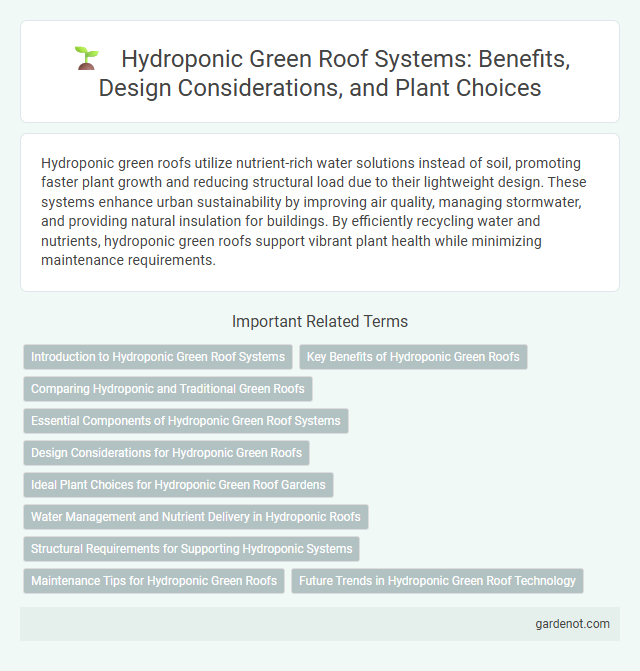Hydroponic green roofs utilize nutrient-rich water solutions instead of soil, promoting faster plant growth and reducing structural load due to their lightweight design. These systems enhance urban sustainability by improving air quality, managing stormwater, and providing natural insulation for buildings. By efficiently recycling water and nutrients, hydroponic green roofs support vibrant plant health while minimizing maintenance requirements.
Introduction to Hydroponic Green Roof Systems
Hydroponic green roof systems utilize soilless cultivation techniques to grow plants on rooftops, optimizing space and water efficiency. These systems rely on nutrient-rich water solutions delivered directly to plant roots, reducing the load on traditional soil substrates and enabling greater control over plant nutrition. Key benefits include enhanced stormwater management, improved thermal insulation, and increased urban biodiversity, making hydroponic green roofs a sustainable solution for modern urban environments.
Key Benefits of Hydroponic Green Roofs
Hydroponic green roofs offer significant water efficiency by circulating nutrient-rich water directly to plant roots, reducing overall consumption compared to traditional soil-based systems. These systems promote healthier plant growth and higher yield potential due to precise control over nutrient delivery and oxygen availability. Enhanced insulation properties of hydroponic green roofs contribute to reduced urban heat island effect and lower building energy costs.
Comparing Hydroponic and Traditional Green Roofs
Hydroponic green roofs use nutrient-rich water solutions instead of soil, allowing precise control over plant nutrition and water usage, resulting in faster growth and reduced weight loads compared to traditional green roofs. Traditional green roofs rely on soil substrates that provide natural microbial ecosystems but require more maintenance and increased structural support due to heavier soil layers. Hydroponic systems enhance drought resistance and minimize runoff, offering a sustainable alternative for urban environments where load capacity and water conservation are critical factors.
Essential Components of Hydroponic Green Roof Systems
Hydroponic green roof systems rely on key components such as a waterproof membrane to prevent water leakage, a root barrier to protect the roof structure, and a nutrient delivery system that supplies plants with essential minerals through a water-based solution. The growing medium, often lightweight and inert, supports plant roots and retains moisture efficiently, while an irrigation system ensures consistent hydration and nutrient distribution. Proper drainage layers maintain water balance, preventing saturation and promoting healthy plant growth on hydroponic green roofs.
Design Considerations for Hydroponic Green Roofs
Design considerations for hydroponic green roofs include selecting appropriate lightweight substrates that facilitate optimal water retention and root aeration while minimizing structural load. Integrating efficient irrigation systems with precise nutrient delivery ensures plant health and reduces water usage in varying climatic conditions. Structural analysis must account for the additional weight of hydroponic components and water, ensuring roof integrity and long-term sustainability.
Ideal Plant Choices for Hydroponic Green Roof Gardens
Ideal plant choices for hydroponic green roof gardens include lightweight, drought-tolerant species such as sedum, succulents, and herbs like thyme and basil, which thrive in nutrient-rich water solutions. Incorporating leafy greens such as lettuce and spinach optimizes growth due to their shallow root systems and fast growth rates suited for hydroponic environments. Selecting plants with high tolerance to varying moisture levels and intense sunlight ensures sustainability and maximizes the efficiency of hydroponic green roofs.
Water Management and Nutrient Delivery in Hydroponic Roofs
Hydroponic green roofs utilize advanced water management systems that recycle and optimize water use, reducing runoff and conserving resources. Nutrient delivery is precisely controlled through automated dosing systems that supply essential minerals directly to plant roots, enhancing growth efficiency and minimizing waste. These technologies create a sustainable micro-ecosystem that supports healthy vegetation while promoting urban water conservation and reducing environmental impact.
Structural Requirements for Supporting Hydroponic Systems
Hydroponic green roofs require robust structural support to handle increased load from water reservoirs, growing media, and plant systems, often exceeding traditional soil-based green roof weights. Load-bearing elements must accommodate dynamic weights caused by water saturation and irrigation equipment, necessitating thorough structural analysis and reinforcement of the roof deck. Waterproofing layers and root barriers are essential to protect the building envelope, while ensuring integration with hydroponic systems minimizes risk of leaks and structural degradation.
Maintenance Tips for Hydroponic Green Roofs
Hydroponic green roofs require consistent monitoring of nutrient solution levels and pH balance to promote healthy plant growth. Regular inspection of filtration systems and pumps ensures optimal water circulation and prevents clogging or system failure. Seasonal adjustments in nutrient concentration and routine cleaning of trays help maintain plant health and extend the lifespan of the green roof system.
Future Trends in Hydroponic Green Roof Technology
Future trends in hydroponic green roof technology emphasize increased integration of smart irrigation systems using IoT sensors to optimize water and nutrient delivery. Advances in lightweight, aerated growing mediums enhance root oxygenation and structural load efficiency, enabling wider application in urban spaces. Emerging developments focus on modular designs that facilitate easy installation, maintenance, and scalability for sustainable building ecosystems.
Hydroponic green roof Infographic

 gardenot.com
gardenot.com